-
 Bitcoin
Bitcoin $106,437.2012
0.82% -
 Ethereum
Ethereum $2,442.5287
0.82% -
 Tether USDt
Tether USDt $1.0005
-0.02% -
 XRP
XRP $2.1812
-0.27% -
 BNB
BNB $645.1327
0.45% -
 Solana
Solana $146.2379
0.39% -
 USDC
USDC $0.9999
-0.01% -
 TRON
TRON $0.2751
0.92% -
 Dogecoin
Dogecoin $0.1662
-0.23% -
 Cardano
Cardano $0.5827
-1.22% -
 Hyperliquid
Hyperliquid $37.5225
0.04% -
 Bitcoin Cash
Bitcoin Cash $479.0877
4.02% -
 Sui
Sui $2.7846
-3.27% -
 Chainlink
Chainlink $13.3576
0.84% -
 UNUS SED LEO
UNUS SED LEO $9.0252
-1.20% -
 Stellar
Stellar $0.2455
-1.07% -
 Avalanche
Avalanche $18.0680
-1.81% -
 Toncoin
Toncoin $2.8948
-1.07% -
 Shiba Inu
Shiba Inu $0.0...01164
-1.65% -
 Litecoin
Litecoin $85.0637
-0.06% -
 Hedera
Hedera $0.1526
-0.89% -
 Monero
Monero $316.2941
0.78% -
 Ethena USDe
Ethena USDe $1.0003
-0.04% -
 Polkadot
Polkadot $3.4113
-1.87% -
 Dai
Dai $1.0000
-0.01% -
 Bitget Token
Bitget Token $4.4488
5.16% -
 Uniswap
Uniswap $7.1740
3.09% -
 Pi
Pi $0.5968
11.43% -
 Pepe
Pepe $0.0...01010
-0.65% -
 Aave
Aave $264.3189
0.40%
Three consecutive gaps must be pulled back? How to deal with different types of gaps?
Three consecutive gaps in crypto trading signal strong momentum, but whether they pull back depends on the gap type and market context.
Jun 25, 2025 at 11:00 am
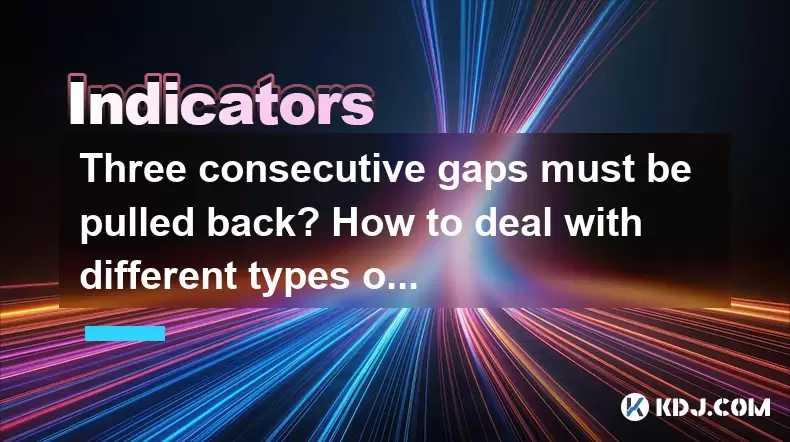
Understanding Gaps in Cryptocurrency Trading
In the world of cryptocurrency trading, price gaps are common occurrences due to the market's 24/7 nature. A gap refers to a situation where the price of an asset jumps from one level to another without any trading occurring in between. These gaps can appear on charts as empty spaces and often occur after significant news events, regulatory changes, or sudden shifts in market sentiment.
Gaps are typically categorized into four types: common gaps, breakaway gaps, runaway (measuring) gaps, and exhaustion gaps. Each type carries different implications for traders and investors. It is crucial to understand these distinctions to make informed decisions when facing multiple gaps in succession.
What Happens When Three Consecutive Gaps Appear?
When three consecutive gaps appear on a chart, especially within a short time frame, it raises questions about whether they will be pulled back or filled. The concept of a gap being "filled" means that the price eventually returns to the level before the gap occurred.
Three consecutive gaps may suggest strong momentum in one direction. However, this does not guarantee that all gaps must necessarily be pulled back. In fact, some gaps—especially breakaway gaps—are rarely filled because they signify the start of a new trend. Traders should evaluate each gap’s context rather than assuming automatic pullbacks.
How to Identify and Categorize Different Types of Gaps
To effectively handle gaps, it's essential to identify their type:
- Common Gaps: These are small gaps that occur frequently and usually get filled quickly. They lack significance and often appear in sideways markets.
- Breakaway Gaps: These signal the beginning of a new trend. They are accompanied by high volume and usually don’t get filled soon after formation.
- Runaway Gaps: Also known as measuring gaps, these occur midway through a trend and indicate continued momentum. They act as confirmation of the ongoing trend.
- Exhaustion Gaps: These appear near the end of a trend and often precede a reversal. They are usually followed by a rapid price movement in the opposite direction.
Identifying the gap type involves analyzing volume, price action, and market context. For example, if a gap appears after a long uptrend with unusually low volume, it might be an exhaustion gap.
Strategies for Dealing with Common Gaps
Common gaps are the easiest to trade since they tend to close relatively quickly. Here’s how you can approach them:
- Look for a gap that appears in a consolidation phase or during low volatility.
- Wait for the price to move back toward the gap area.
- Set a limit order near the gap zone to enter a position in the direction of the expected pullback.
- Place a stop-loss just beyond the gap to manage risk.
- Target the previous support or resistance level once the gap is filled.
Because these gaps are frequent and predictable, many traders use them for short-term scalping strategies.
Handling Breakaway and Runaway Gaps
Breakaway and runaway gaps are more complex and require a different strategy:
- After identifying a breakaway gap, consider entering a trade in the direction of the breakout.
- Use volume confirmation—if the gap occurs with a spike in volume, it strengthens the validity of the breakout.
- Place a stop-loss below the previous consolidation zone or key support level.
- For runaway gaps, look to add to existing positions or initiate new ones once the gap confirms continued momentum.
- Always monitor the distance traveled from the original breakout point; runaway gaps often appear halfway through a trend.
These types of gaps are not meant to be traded for immediate pullbacks but rather as opportunities to ride the emerging or continuing trend.
Managing Exhaustion Gaps and Avoiding False Signals
Exhaustion gaps can be deceptive. They often appear after extended moves and mimic runaway gaps but lead to reversals instead. To avoid false signals:
- Watch for signs of weakening momentum such as lower volume compared to earlier gaps.
- Observe candlestick patterns at the gap area—spinning tops or dojis can indicate indecision.
- Enter trades only after confirming the reversal with additional indicators like RSI or MACD.
- Consider using options or futures contracts to hedge against unexpected reversals triggered by exhaustion gaps.
Timing is critical when dealing with exhaustion gaps. Entering too early can result in losses, while waiting for confirmation may reduce profit potential.
Frequently Asked Questions
Q1: Can gaps in cryptocurrency markets be predicted?
While gaps cannot be predicted with certainty, traders can anticipate them by monitoring major news events, regulatory announcements, and macroeconomic factors that influence crypto prices.
Q2: Do all gaps eventually get filled?
No, not all gaps get filled. Breakaway and runaway gaps often remain unfilled, especially if they align with strong trends. Only common and exhaustion gaps are more likely to see price return to pre-gap levels.
Q3: Is it safe to trade gaps on low liquidity exchanges?
Trading gaps on low liquidity exchanges can be risky due to slippage and unreliable price data. It’s advisable to focus on major exchanges with higher trading volumes to ensure accurate execution and reliable gap identification.
Q4: How can I distinguish between a runaway gap and an exhaustion gap?
A runaway gap appears mid-trend with strong volume and supports continuation, while an exhaustion gap shows up at the end of a trend with weak volume and is often followed by a reversal.
Disclaimer:info@kdj.com
The information provided is not trading advice. kdj.com does not assume any responsibility for any investments made based on the information provided in this article. Cryptocurrencies are highly volatile and it is highly recommended that you invest with caution after thorough research!
If you believe that the content used on this website infringes your copyright, please contact us immediately (info@kdj.com) and we will delete it promptly.
- Binance Lists Newton Protocol: Airdrop Ignites NEWT Token Surge!
- 2025-06-26 00:45:12
- SPX6900, Meme Coins, and DogWifHat Bulls: What's Happening?
- 2025-06-26 00:45:12
- Crypto Meme Coins: Riding the Upside Potential Wave
- 2025-06-26 00:25:12
- Moca Chain: Revolutionizing User Verification with Self-Sovereign Identity
- 2025-06-26 00:25:12
- US Mint Goes Comic Book Cool: Superman, Batman, and Wonder Woman on Coins!
- 2025-06-26 00:52:13
- Rohit Sharma's T20 World Cup Triumph: A Toss to Remember Against Pakistan
- 2025-06-26 00:55:12
Related knowledge
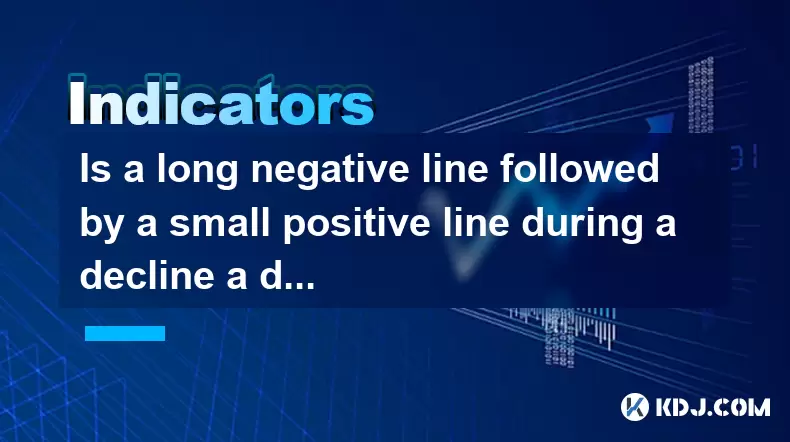
Is a long negative line followed by a small positive line during a decline a decline relay?
Jun 26,2025 at 12:21am
Understanding Candlestick Patterns in Cryptocurrency TradingIn the realm of cryptocurrency trading, candlestick patterns play a crucial role in analyzing price movements. These visual representations help traders identify potential reversals, continuations, or consolidation phases. One such pattern that often appears during downtrends is a long negative...
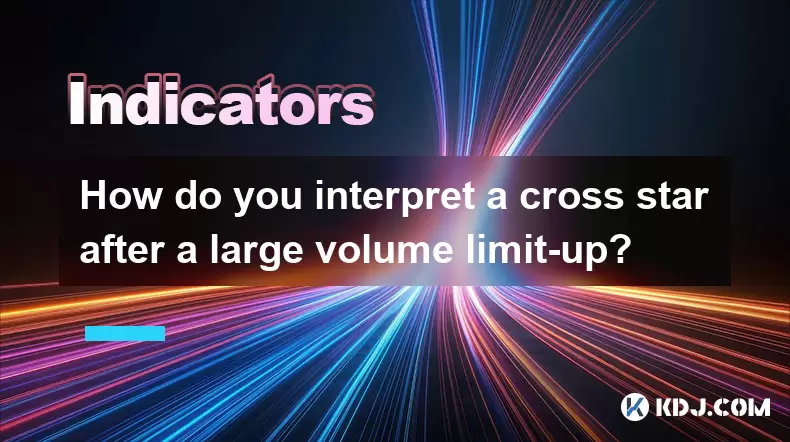
How do you interpret a cross star after a large volume limit-up?
Jun 25,2025 at 11:01pm
Understanding the Cross Star Pattern in Cryptocurrency ChartsIn cryptocurrency trading, candlestick patterns play a crucial role in technical analysis. One such pattern is the cross star, which typically appears as a candle with small real body and long upper and lower shadows. This pattern often signals market indecision and can indicate a potential re...

When the volume shrinks to 30% of the breakthrough volume when stepping back after breaking through the platform?
Jun 25,2025 at 09:49pm
Understanding Breakthrough Volume in Cryptocurrency TradingIn the world of cryptocurrency trading, volume is a crucial indicator that reflects market sentiment and price action. When a cryptocurrency breaks through a key resistance level or a consolidation platform, it often comes with a surge in trading volume. This breakthrough volume signals strong b...
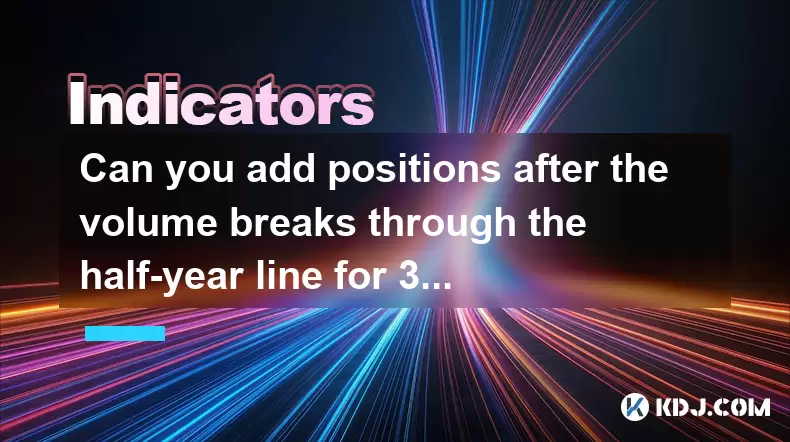
Can you add positions after the volume breaks through the half-year line for 3 consecutive days with reduced volume?
Jun 25,2025 at 08:00pm
Understanding the Half-Year Volume Line in Cryptocurrency TradingIn cryptocurrency trading, technical indicators often guide traders in making decisions. One such metric is the half-year volume line, which refers to the average daily trading volume over a 180-day period. When traders refer to a volume breakout above this line, they are observing whether...
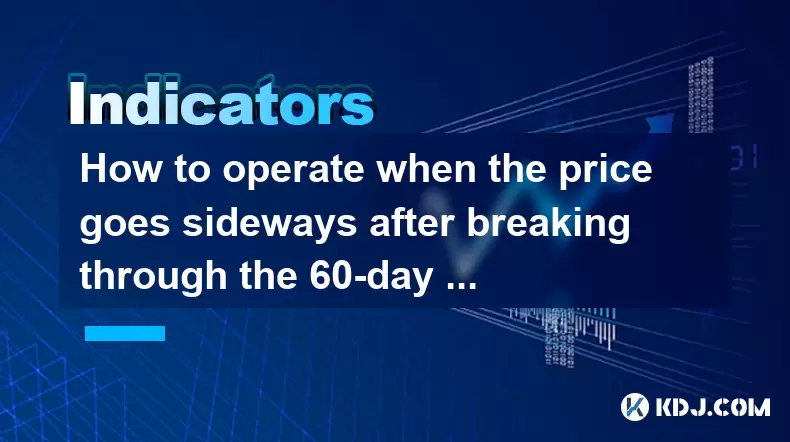
How to operate when the price goes sideways after breaking through the 60-day line with large volume?
Jun 25,2025 at 07:08pm
Understanding the 60-Day Line Breakout with High VolumeWhen a cryptocurrency asset breaks through its 60-day moving average line with large volume, it often signals a potential shift in momentum. This kind of breakout typically suggests that institutional or large retail traders are entering the market aggressively. However, when the price starts to mov...
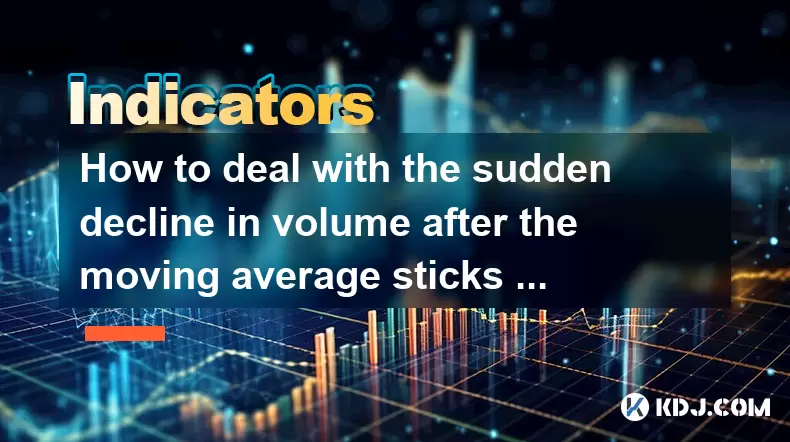
How to deal with the sudden decline in volume after the moving average sticks together?
Jun 25,2025 at 06:35pm
Understanding the Moving Average Convergence and Its ImplicationsIn the world of cryptocurrency trading, moving averages (MAs) are essential tools used to identify trends and potential reversals. When multiple moving averages converge or 'stick together,' it often indicates a period of consolidation or indecision in the market. This phenomenon can be ob...

Is a long negative line followed by a small positive line during a decline a decline relay?
Jun 26,2025 at 12:21am
Understanding Candlestick Patterns in Cryptocurrency TradingIn the realm of cryptocurrency trading, candlestick patterns play a crucial role in analyzing price movements. These visual representations help traders identify potential reversals, continuations, or consolidation phases. One such pattern that often appears during downtrends is a long negative...

How do you interpret a cross star after a large volume limit-up?
Jun 25,2025 at 11:01pm
Understanding the Cross Star Pattern in Cryptocurrency ChartsIn cryptocurrency trading, candlestick patterns play a crucial role in technical analysis. One such pattern is the cross star, which typically appears as a candle with small real body and long upper and lower shadows. This pattern often signals market indecision and can indicate a potential re...

When the volume shrinks to 30% of the breakthrough volume when stepping back after breaking through the platform?
Jun 25,2025 at 09:49pm
Understanding Breakthrough Volume in Cryptocurrency TradingIn the world of cryptocurrency trading, volume is a crucial indicator that reflects market sentiment and price action. When a cryptocurrency breaks through a key resistance level or a consolidation platform, it often comes with a surge in trading volume. This breakthrough volume signals strong b...

Can you add positions after the volume breaks through the half-year line for 3 consecutive days with reduced volume?
Jun 25,2025 at 08:00pm
Understanding the Half-Year Volume Line in Cryptocurrency TradingIn cryptocurrency trading, technical indicators often guide traders in making decisions. One such metric is the half-year volume line, which refers to the average daily trading volume over a 180-day period. When traders refer to a volume breakout above this line, they are observing whether...

How to operate when the price goes sideways after breaking through the 60-day line with large volume?
Jun 25,2025 at 07:08pm
Understanding the 60-Day Line Breakout with High VolumeWhen a cryptocurrency asset breaks through its 60-day moving average line with large volume, it often signals a potential shift in momentum. This kind of breakout typically suggests that institutional or large retail traders are entering the market aggressively. However, when the price starts to mov...

How to deal with the sudden decline in volume after the moving average sticks together?
Jun 25,2025 at 06:35pm
Understanding the Moving Average Convergence and Its ImplicationsIn the world of cryptocurrency trading, moving averages (MAs) are essential tools used to identify trends and potential reversals. When multiple moving averages converge or 'stick together,' it often indicates a period of consolidation or indecision in the market. This phenomenon can be ob...
See all articles























































































